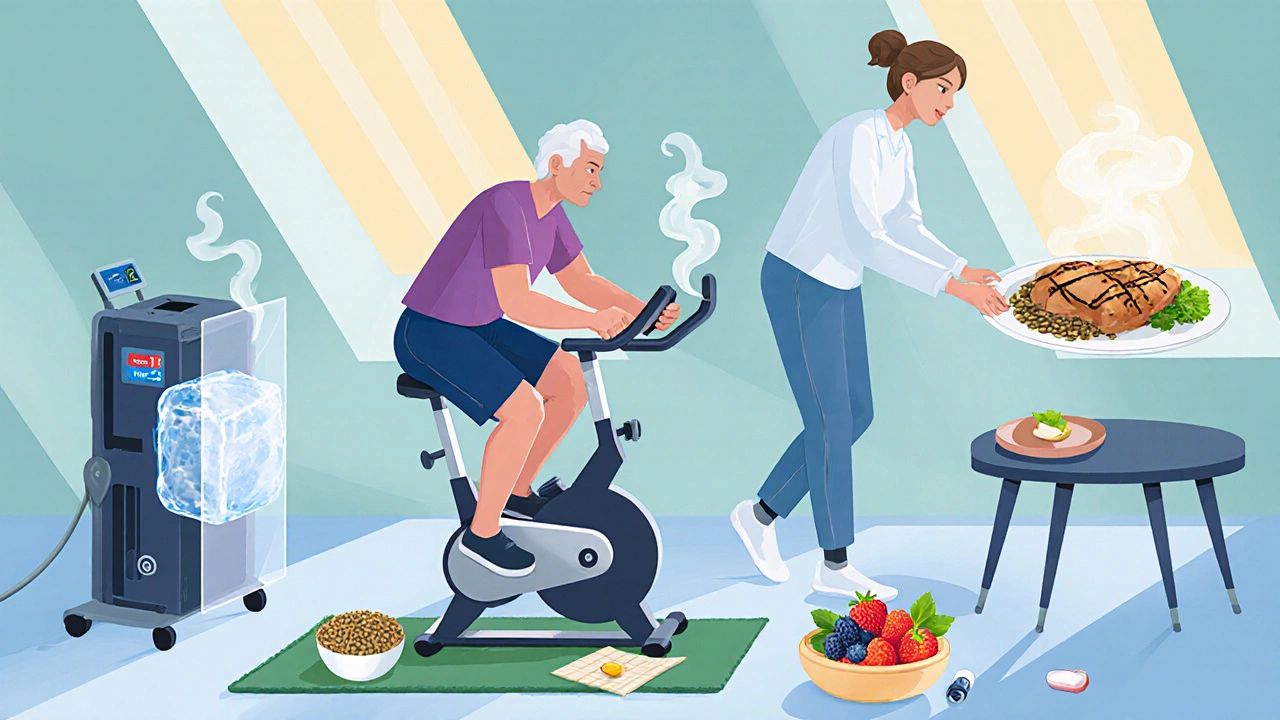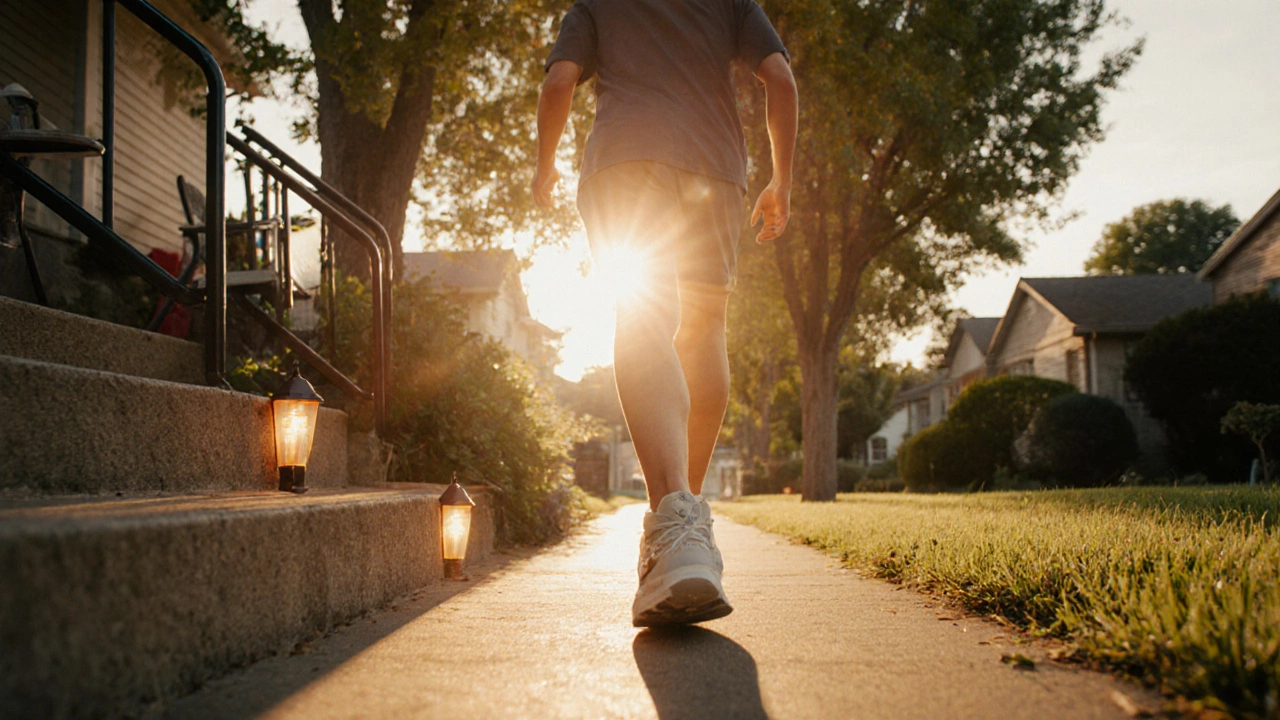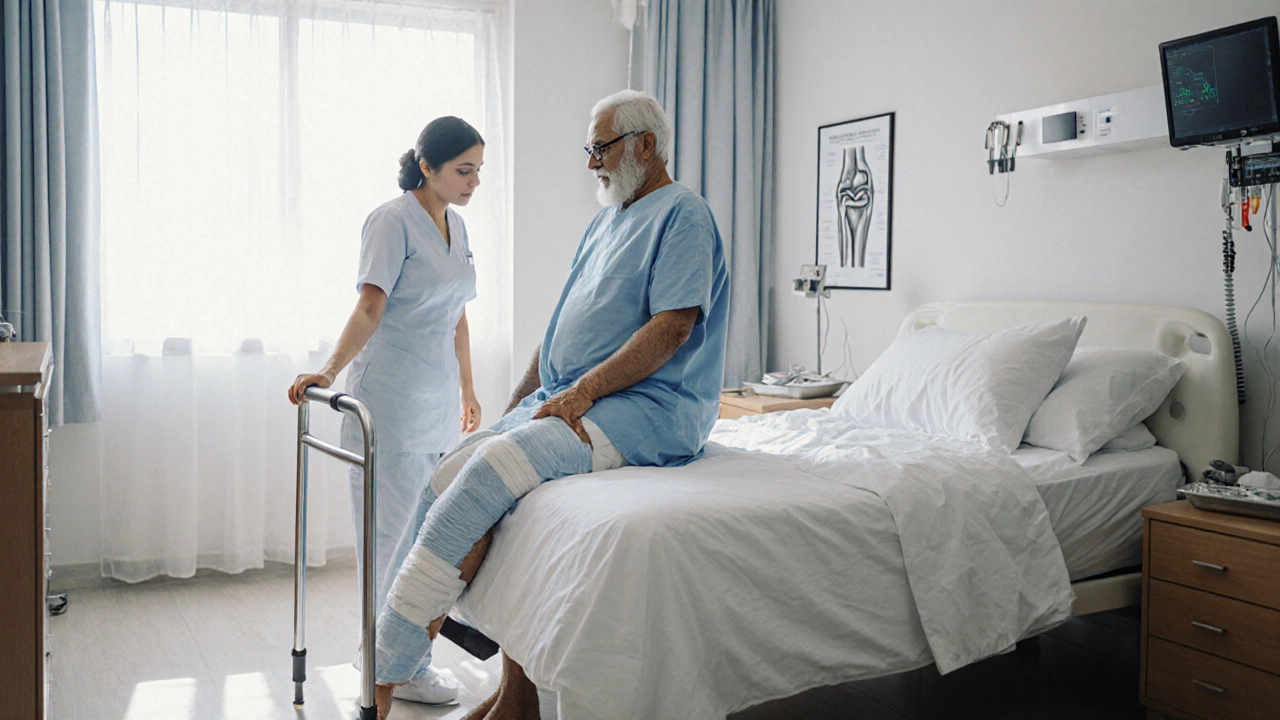Did you know that patients who follow an accelerated rehab plan can walk unaided in as little as knee replacement recovery 6 weeks, instead of the typical 12‑week mark? That speed isn’t a myth - it’s the result of science‑backed steps you can start right after surgery.
Knee Replacement Recovery is the process of healing and regaining function after a total knee arthroplasty (TKA). It involves managing pain, restoring range of motion (ROM), rebuilding muscle strength, and safely progressing to daily activities. The goal is to get you moving confidently, without lingering stiffness or swelling.
What Actually Happens During a Knee Replacement?
In a total knee arthroplasty, the damaged cartilage and bone surfaces are removed and replaced with metal and plastic implants. Surgeons align the components to mimic natural knee motion. While the operation itself usually lasts 1-2 hours, the post‑op phase is where speed matters most.
Core Principles That Speed Up Recovery
- Early Mobilisation - Getting the joint moving within the first 24 hours reduces scar tissue formation.
- Controlled Pain Management - Balanced use of NSAIDs, nerve blocks, and limited opioids keeps you comfortable enough to exercise.
- Targeted Physiotherapy - Specific ROM and strengthening drills that match the healing timeline.
- Optimised Nutrition - Adequate protein, vitamin C, and zinc accelerate tissue repair.
- Adjunct Modalities - Ice therapy, compression, and, when appropriate, a continuous passive motion (CPM) machine support joint health.
Day‑by‑Day Timeline for the Fastest Recovery
- Day 0 (Surgery Day): After anesthesia wears off, a nurse will help you stand and take a few steps with a walker or crutches. Your surgeon will apply a sterile dressing and a cold‑pack wrap.
- Day 1-2: Begin passive ROM exercises (heel slides, quad sets) under the guidance of a physical therapist. Ice for 20 minutes every 2 hours to keep swelling under 2 cm.
- Day 3-5: Transition to active-assisted ROM - straight‑leg raises, seated knee extensions, and gentle stationary‑bike sessions (0 resistance). If prescribed, start CPM for 2 hours daily.
- Week 2: Full weight‑bearing as tolerated. Increase stationary‑bike resistance to level 2, begin short walks of 10‑15 minutes, and add wall sits (30 seconds, 3 sets). Continue ice and start a protein‑rich diet (1.5 g/kg body weight).
- Weeks 3-4: Add closed‑chain exercises - mini‑squats, step‑ups on a 6‑inch platform, and balance work on a foam pad. Aim for 3 physiotherapy sessions per week and daily home exercises.
- Month 2-3: Introduce low‑impact cardio (elliptical, swimming). Progress to full squats (if pain‑free), lateral lunges, and resistance band work. Most patients can return to light household chores.
- Month 4-6: Strengthen hamstrings with hamstring curls, add light weight‑training, and practice dynamic activities (e.g., stair climbing). By six months, many achieve near‑normal gait without assistive devices.

Key Interventions That Make a Real Difference
Physical Therapy Protocols
Choosing an accelerated protocol means you’ll start weight‑bearing on day 1 and increase exercise intensity weekly. Studies from the Journal of Orthopaedic & Sports Physical Therapy (2024) show a 30 % reduction in total recovery time when the protocol follows the “early‑active” model.
Continuous Passive Motion (CPM) Machine
While not mandatory, CPM can keep the joint moving while you rest. Set the machine to 0‑30° flexion for the first 48 hours, then gradually increase to 0‑90° over the next week. Meta‑analysis (2023) links CPM use to a 15 % improvement in early ROM.
Ice Therapy & Compression
Cold reduces inflammation by constricting blood vessels. Use a gel pack or circulating cold system for 20 minutes, then remove for at least 40 minutes. Pair with a compression sleeve to limit fluid buildup.
Nutrition for Healing
- Protein: 25‑30 g per meal (lean meat, legumes, dairy).
- Vitamin C: 500 mg daily to support collagen synthesis.
- Zinc: 15 mg daily for immune function.
- Omega‑3 fatty acids: 1 g daily to modulate inflammation.
Pain Management Strategy
Combine a peripheral nerve block (lasting 12‑24 hours) with scheduled acetaminophen and ibuprofen. Reserve short‑course opioids for breakthrough pain only. This multimodal approach reduces opioid use by up to 70 % and encourages early movement.
Accelerated vs. Standard Rehabilitation (Quick Comparison)
| Aspect | Accelerated | Standard |
|---|---|---|
| Start of Weight‑Bearing | Day 1 (as tolerated) | Day 3‑5 |
| Daily PT Sessions | 3 sessions/week, plus home program | 2 sessions/week |
| Range‑of‑Motion Goal (Weeks) | 0‑90° by week 2 | 0‑90° by week 4 |
| Full‑Weight Walking Without Aid | 4‑6 weeks | 8‑10 weeks |
| Expected Return to Light Activities | 6‑8 weeks | 10‑12 weeks |

Common Pitfalls and How to Avoid Them
- Skipping Early Motion - Waiting more than 48 hours to move the knee increases stiffness risk. Set a reminder to do quad sets every hour while resting.
- Over‑reliance on Pain Medication - Excessive opioids dull the sense of safe movement, leading to delayed strengthening.
- Neglecting Nutrition - Protein below 1 g/kg slows muscle rebuild. Track meals with a simple app.
- Ignoring Swelling - Persistent edema beyond week 2 often signals inadequate compression or too‑aggressive activity.
- Returning to High‑Impact Sports Too Soon - High‑impact activities should be postponed until at least 9‑12 months, after full strength is regained.
Mini‑FAQ: Quick Answers to Your Burning Questions
How soon can I walk without crutches?
Most patients in an accelerated program can ditch crutches by week 4 if pain is controlled and gait is stable.
Is a CPM machine necessary?
Not mandatory, but it helps maintain early ROM and can shave off a few days of stiffness.
What pain meds are safest after knee replacement?
A combination of scheduled acetaminophen (1 g every 6 h) and ibuprofen (400 mg every 8 h) with a short‑term opioid for breakthrough pain works best.
When can I start cycling?
A stationary bike with no resistance is safe from day 2; increase resistance after week 3 as tolerated.
How important is sleep for recovery?
Critical - deep sleep releases growth hormone, which drives tissue repair. Aim for 7‑9 hours, elevate the leg, and keep the room cool.
Next Steps: Building Your Personal Recovery Plan
1. Book a pre‑op physiotherapy consult - they’ll customize the day‑1 exercise sheet.
2. Set up nutrition basics - order a high‑protein snack pack and a vitamin C supplement before discharge.
3. Arrange home safety - remove loose rugs, place night‑lights, and keep a sturdy chair near the bathroom.
4. Schedule follow‑up appointments - 2 weeks, 6 weeks, and 3 months to monitor progress and adjust the plan.
By following this structured, evidence‑based roadmap, you’re not just healing - you’re speeding up the journey back to the activities you love.
